House of Ghosts
In Hamburg's new Nazi bunker extravaganza for the leisure society, phantoms of a forever war lurk in every nook and corner. Inspection of a building with built-in abysses.
On July 5, 2024, a new tourist attraction opened in Germany's second-largest metropolis. The city's PR agency “Hamburg Marketing” advertised it as the “most spectacular construction project in Hamburg since the opening of the Elbphilharmonie” in 2017, highlighting the “public roof garden at a height of 58 meters”, praising the “exciting gastronomy” and the “unique panoramic view over the city”. Of course, the building also improves the “urban climate” thanks to its lush greenery. In summary, “a new creative, urban experience” was created here, Hamburg's new “architectural, metropolitan development and tourism highlight in the middle of the lively St. Pauli district”.
The advertising worked. On the very first day, thousands made their way up the external staircase to experience the first ascent. There was a festival atmosphere: “Thank you, Adolf Hitler! Without the Führer's visionary energy, the Hanseatic city would not have been able to inaugurate its new jewel of the third millennium! Hooray for the bold designs of National Socialist construction planning and their durability far beyond the day!” Sorry, but I just had to make up this fictitious propaganda stream in the zeitgeist of more than 80 years ago in my mind and put it alongside today's very differently sounding hyperbole. Even at the risk of looking into embarrassed faces. Otherwise, it would be all too easy to be dazzled and end up hailing the now officially named “Green Bunker” on Heiligengeistfeld as a gift to the citizens of the city from an appropriately colored ruling party.
Nothing could be more historically and currently wrong. The sober fact is that a private investor repurposed a gigantic high-rise bunker from the Nazi era, which was rotting away as a non-demolishable remnant of the Second World War, for a total of 90 million euros. He added another five floors with hotel, shopping and restaurant areas. In addition, a newly created staircase with 335 steps now leads along the outer façade, past more than 20,000 newly procured green plants, all the way up to the grass-covered roof terrace. Presumably there was public “climate protection” funding for this, but “Hamburg Marketing” makes as little mention of this as the name of the investor. In any case, the hotel belongs to the “Hard Rock” chain, which also operates the world-famous Hard Rock cafés (and there is now a branch of this gastro franchise in the bunker). On its website, I found not the slightest reference to the warlike Nazi foundation of its new location. Except perhaps as a faint echo in the hotel name: “Reverb”. Hard rock, indeed.
But without background knowledge, guests are on their own should they experience any nightmares in their hotel beds. Hardly anything is as (pop) culturally contradictory and conducive to cognitive dissonance as this gray-green monster of reinforced concrete. No matter how thoroughly we greenwash it: we Hamburgers and Germans as a whole will be gnashing our teeth at it for another hundred years. If we can hold out that long, while it will definitely welcome the 22nd century. This building is not going anywhere. And in the meantime, it is doing something to us. Even on its open staircases, I still stand in its long, dark shadow. And having finally climbed its green roofscape, I feel its 3.80-metre-thick ceiling still weighing heavily on the soul.
But before I can perhaps explain how this building full of shadows and ghosts from another era fooled my imagination during my visit (“mindfuck” is the more poignant word), I must preface it with the concrete-hard historical facts.
One of the largest of all bunkers built by the National Socialists was originally christened with a very German name: “Flakturm IV”. Flak, abbreviation for the anti-aircraft guns on its roof platform, IV for the fourth bunker construction project of this kind in the German Reich as per the start date in April 1942. The bombing war that the Wehrmacht had unleashed on the western and eastern fronts had long since returned to the Reich territory like a boomerang. The bunker was to provide shelter for 18,000 Hamburg residents. The Nazis also used up to 2,400 forced laborers from the conquered territories during construction. In July 1943, when Flak Tower IV was opened to the civilian population, up to 30,000 people crowded into it.
These lucky - or not totally unlucky - people got inside just in time before “Operation Gomorrah” of the bomber units from Great Britain and the USA finally culminated in the Hamburg “firestorm” at the end of July 1943 with around 34,000 deaths. The vast majority of those killed by the bombs in the city were women, children and old men - the boys were at the front. At the Ohlsdorf cemetery, where many of the Allied war graves are located, a touching memorial was erected many years ago to the victims of the air war in Hamburg. Each headstone for an extinguished life is planted with a red rose. There is also a collective place of remembrance for the unknown victims.
Whether this garden of the dead would be created again today under the current city government is more than questionable. In the Flakturm bunker, for example, there is to be a memorial for the forced laborers, which seems only appropriate. One for the victims of the Allied terror bombs, however, is not planned. The German civilians who burned to death in Hitler’s war no longer have a lobby.
However, Flak Tower IV was not only intended to provide passive protection from the carpet bombing, but also to actively defend the city's airspace: Combined with an equally massive second concrete structure within sight, which no longer exists today and on whose roof the fire control radar was located, this flak tower was the strategic location for two heavy twin guns and four smaller anti-aircraft batteries. In connection with another anti-aircraft tower on the Elbe island in south-eastern Wilhelmsburg, it dominated the ground-to-air defense for the whole of Hamburg. The following picture shows an identical bunker ensemble in Berlin:
Due to a severe lack of trained soldiers, 35 schoolboys, an entire class, were also deployed as “anti-aircraft helpers” in the flak position on Tower IV right from its commissioning in March 1943. This is where the cognitive dissonance that I mentioned at the beginning comes into play. There are historical photos in the bunker on Heiligengeistfeld showing some of these perhaps 16-year-olds in uniform at the heavy steel anti-aircraft guns (unfortunately I am unable to show them here).
The faces of these boys are not distorted with fear or marked by disgust at the duty they were ordered to perform. No, their expressions tell of a thirst for adventure and pride. They, who long to be “real German men”, are allowed to defend the Reich and the city with these huge and awesome cannons! They are the chosen few, deemed worthy of the responsibility! At the time the photos were taken, presumably before the first of the great night raids by a thousand bombers in several waves, these Hamburg boys show themselves full of heroic determination. That is what their faces express: rapture. They are part of a hot-running machine that is infinitely bigger than themselves. The opposite of the gesture I described here (in German) three years ago.
And that is what this building also radiates. In addition to all the horrors and inhumanities that were cast in concrete here, it conveys an idea of greatness and indomitability that leaves today's Germans shuddering helplessly. Over generations, we have unlearned how to deal with this attitude. Others have taken it from us, we in the Shire are clueless in the face of such things. Perplexed, but with goose bumps that still tell of old reflexes. Those who allow them inside themselves in order to understand them experience disturbing inner processes. The thrilling fear (“angstlust” in German) that announces the distant proximity of the old, real Nazis in their steel helmets and leather boots.
Before you can suppress it, for example, there is this impulse, this twitching flame of aesthetic fascination. It flares up when you learn from the few information boards in the bunker that this depressingly gray block would not have been commercially greened if the war had been won. No, it would have been completely clad in white marble. That was Hitler's idea, apparently. After the endsieg or final victory, the bunker was to be transformed into a kind of party palace where National Socialist receptions, exhibitions and congresses would be held. For this purpose, even the current window openings in the meter-thick outer walls were cut out - and then re-filled with concrete so that they vanished for wartime use. The splendor and megalomania of the Third Reich: here stands their undead house of ghosts, their zombie mausoleum.
The walls of the reserve fire control post, which stood in if the main radar in the tower opposite failed, are still preserved a few meters below the new inofficial picnic lawn. The armored doors through which officers and signalmen entered and exited. The spiral staircase, which was intended to ensure that the bunker was filled as quickly as possible and that people were distributed smoothly to its various levels. All of this is still there, 80 years later. Above all, however, this enormous collective will, in the sense of ambition, still lingers. Built into the steel girders, compressed and immortalized in the concrete. A Germany that we no longer understand wanted to prove itself: defying a “world of enemies”, withstanding Jünger's “storm of steel”. Well, as a mummified corpse, that Germany has persevered here. Its shrill voice faintly reverberating in echoes of echoes.
And we today dutifully use the window caves so foresightedly planned in advance by the ghosts. This is the second cognitive dissonance that inevitably arises up here: Where would we be without them who built this? Well, at least we would have been left without a chance for up-building. I wander through the dining room of a restaurant and bar. Tourists sit at its panoramic windows, sipping cocktails for 16 euros each and capturing the view of the FC St. Pauli soccer stadium on their cell phones.
What is it like to lounge here where the firebombs fell at night? Can you still hear the wailing of the sirens, the thunder of the anti-aircraft guns, the roar of the mighty Lancaster bomber engines in the sky? Can you still see the ghostly beams from the searchlights cutting through the gloomy layers of cloud? The phosphorus tracer ammunition that conjured up macabre “Christmas trees” in the night sky to mark the targets? The glow of fires at all ends of the hard-hit city? Can you smell the thick black smoke of the firestorm, the suffocating mortar dust of the collapsing tenements?
No, what we see down there are the millions of lights of the Hamburg “Dom”, the big funfair on the Heiligengeistfeld. Rides and rollercoasters spread their whirling noise, bass speakers thump the beats to funfair techno, fumes of roasted almonds and fried fish rise up from the depths. Do we want to go shopping first, or go straight to the hotel room and ... play St. Pauli?
Of course you could say: it's the best solution, such a green tourist magnet in the middle of the city; better than just letting the rugged and slippery concrete mountain rot away like that, as a metaphorical lump of crudeness. Tearing down three-meter-thick walls is less of an option today than ever before; we need the billions of euros elsewhere, for example to plug the fattest holes in our collapsing social systems. Plus, the solution we have found is probably the most visually satisfying, the most life-affirming one. But all the fun, the panoramic views, the coolness and the hype cannot banish the evil spirits in this house of anachronisms for good. As a hotelier, I would not have dared to base my investment on this particular genius loci.
The third cognitive dissonance, which accompanies me like a creeping shadow on my bunker tour, is perhaps the most brutal, the most disturbing. It doesn't nest in the past, it comes from the future. This building is testimony to the fact that the world will never be the paradise of peace as which it appears to the generations who have not yet seen war. Tirelessly, but unmistakably, it whispers from all the bunker walls to the revelers and shoppers, the beautiful young people of St. Pauli: Come in, come in, hurry up, soon it will be closing time again! Soon you will long for the protection of these walls like your grandmothers did! It is, however, unlikely that they will be able to withstand today's nuclear bombs, as you have done your level best to “disempower” this old edifice of faith. Wouldn't you be better advised to simply go out into the park and step into the bright white light?
For the signs are pointing to war. Those who are still celebrating the leafy green of “climate protection” here today are the same people who want to put the olive green of the Bundeswehr uniform on the country's remaining sons and send them to the imaginary defense line of Western values. To this end, they have already passed a law that prohibit genetic males from defining themselves differently when drafted into the military, despite the new freedom to self-determine their gender. And they, who declare borders unprotectable, are already making German Leopard tanks roll from Ukrainian soil into Russia as weapons of attack. In this way, they are once again closing the bond with their Nazi grandparents that they thought they had successfully severed.
I leave the bunker of green-colored poisonous thoughts with anxious trepidation. The cuddly cartoon figures with Hanseatic sailor caps on the walls, which would probably not have delighted the Führer, show me the way to the stairs from the control room. Like cattle, we visitors are separated by bars at the exit and channelled through turnstiles. But unlike at the entrance, we pass through unchecked. Because out there, we are free to be defenseless wherever we want. Perhaps only a few will soon be allowed back inside.




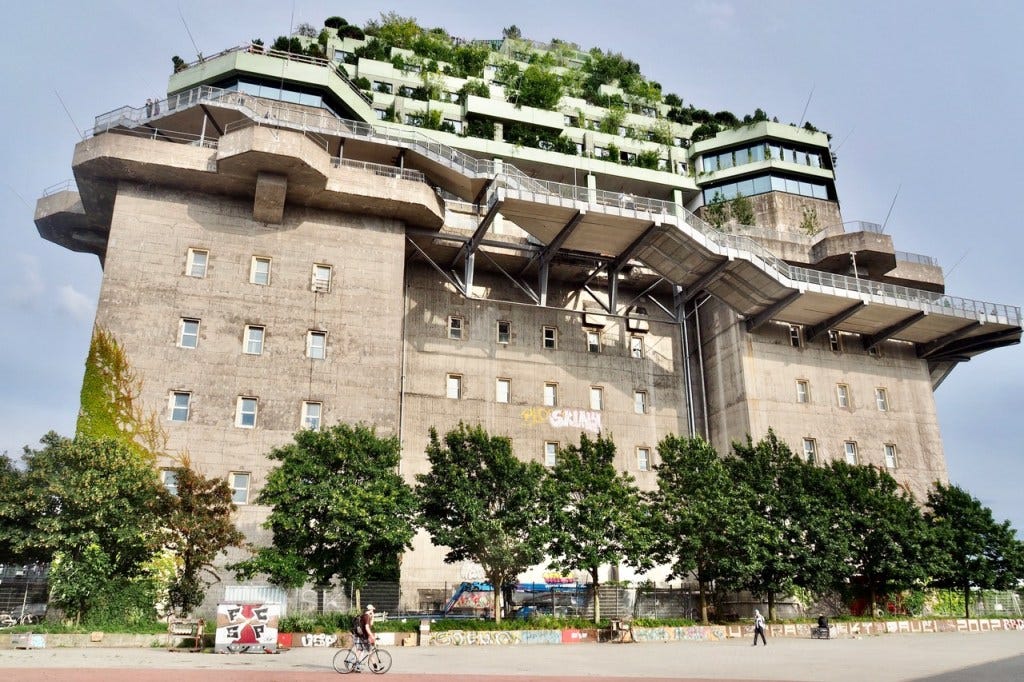

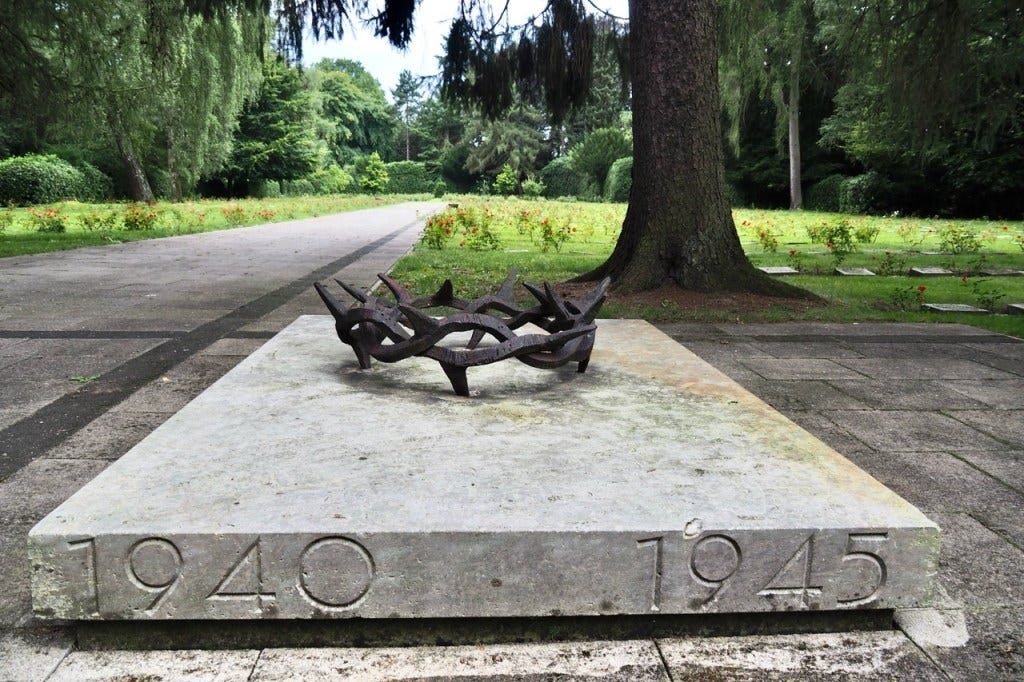

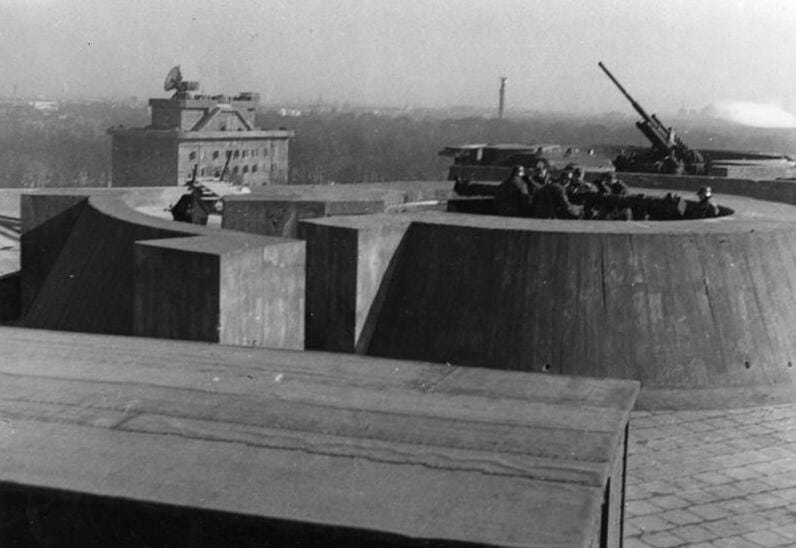
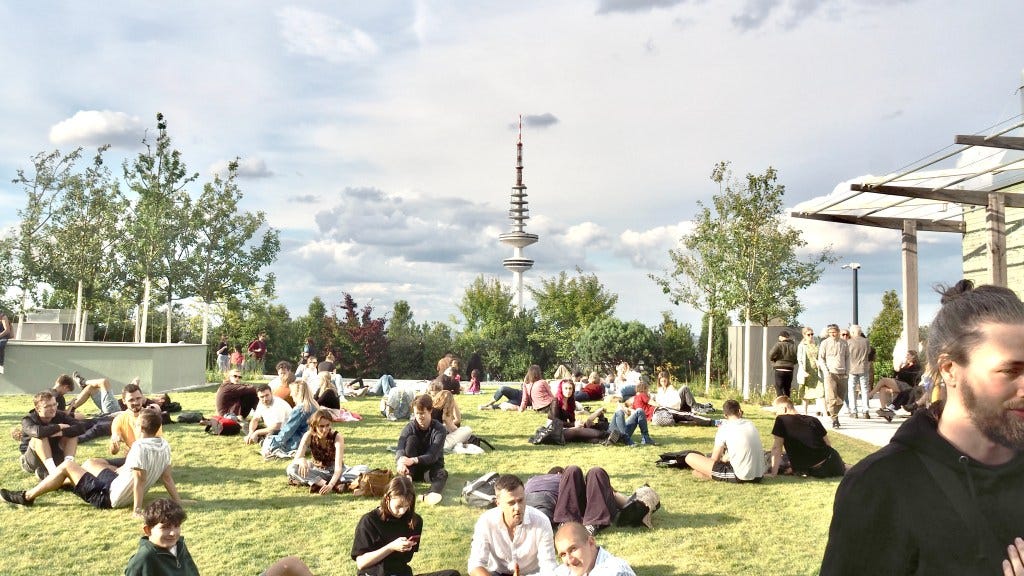
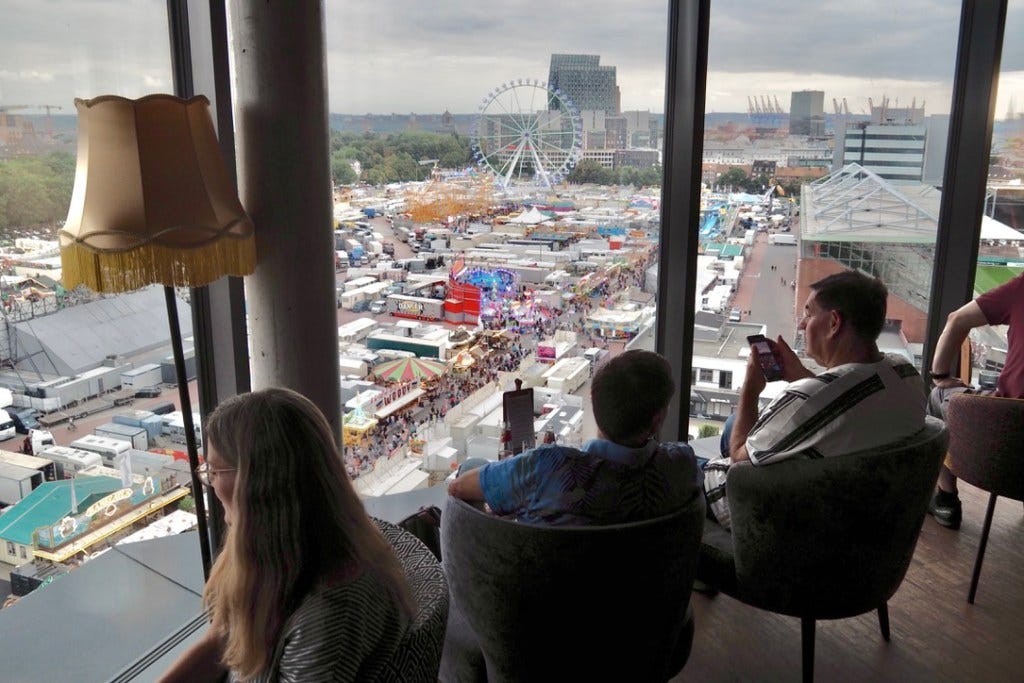
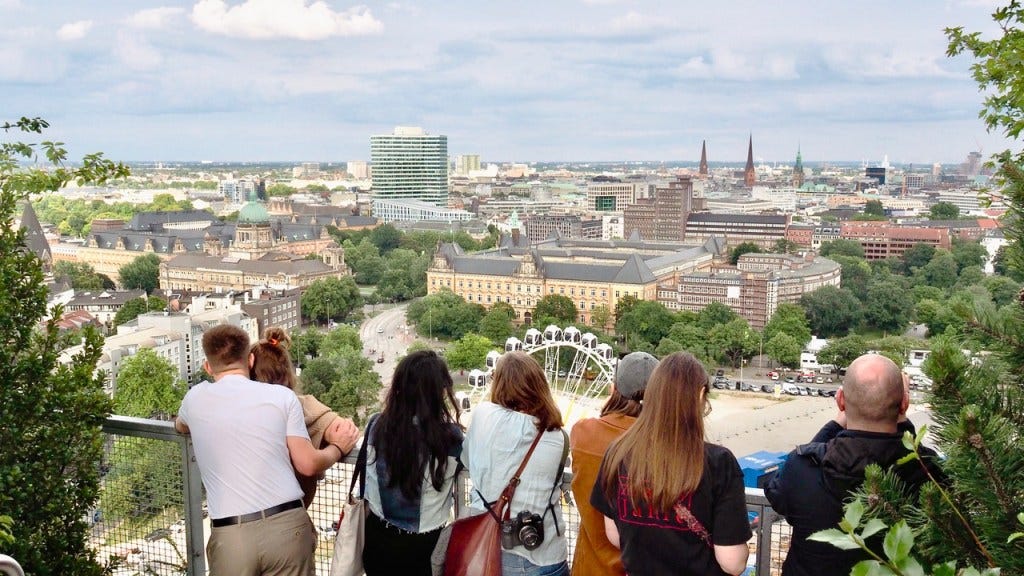
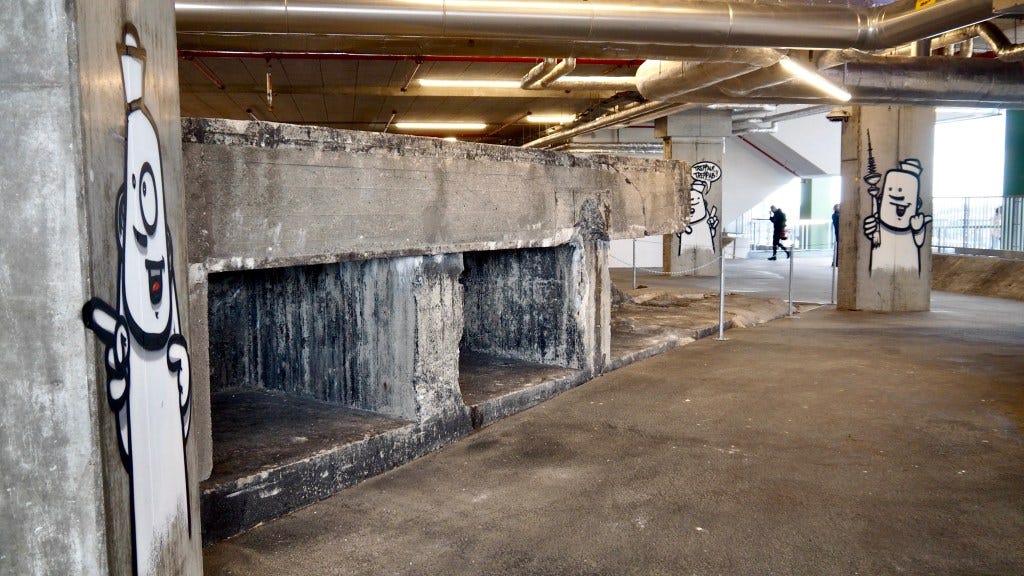
it's an object in tension. It tries to be hip instead of somber but it feels tacked on. The bunker seems ready to shake off the flimsy bits on top at any moment. In fact, eventually, the hotel will go bust as they always do, but the bunker will stay much the same.
On reflection i kind of like it, but I'm also glad i don't have to look at this every day.
Hallo! I only recently discovered your writing - as a long term expat Northern German I really enjoy reading you. I don’t read much German anymore these days but your pieces in German or in English on Northern German locations/topics take me back to my roots, in a good way. Forgive me for not addressing you in German. I was wondering: Have you read “The Fourth Turning” by Howe and Strauss? Depressing but interesting read about the (almost?) inevitability of what you describe. 80 years after the end of World War II we are about to end up potentially in a civilization ending war. The Fourth Turning explains why…